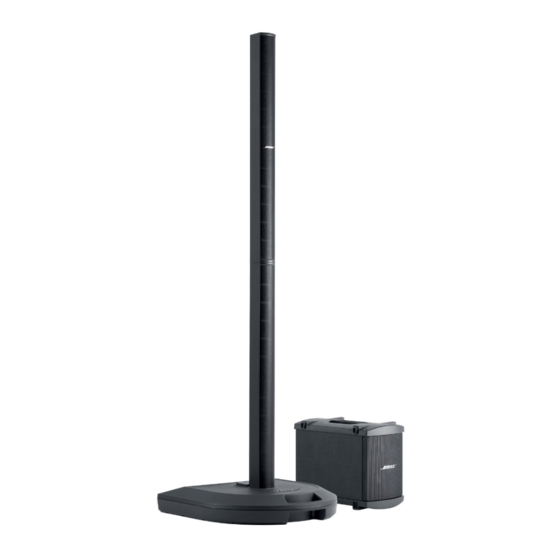Bose Personalized Amplification System Manual de solución de problemas - Página 27
Navegue en línea o descargue pdf Manual de solución de problemas para Amplificador Bose Personalized Amplification System. Bose Personalized Amplification System 50 páginas.
También para Bose Personalized Amplification System: Manual del usuario (28 páginas)

PS1 Power Stand Tests
Equipment Required
•
dB Meter
•
Digital Multi-meter
•
Audio Signal Generator
•
Distortion Meter
•
3 - 4 Ohm, 250 Watt Load Resistors
•
Test cables, see Appendix
Overall PS1 System Tests
Notes:
1. Connect 4 Ohm load resistors to the
channel 1, 2 and 3 outputs on the PS1
power stand using the test cables described
in the appendix of this troubleshooting guide.
2. Do not connect the R1 remote control for
the following tests. This has the same effect
as setting all of the controls on the remote to
the midpoint.
3. On the front panel of the PS1, set the
Channel 1 and Channel 2 Preset Select
switches to 00. This will put the PS1 into
debug mode for the following tests. In this
mode the crossover, the compressor and the
EQ are disabled. The DSP will pass a flat
response. The level controls and the clip
indicators still operate in this mode.
1. Channel 1 and 2 Mic Input Gain Tests
1.1 Place a 1/4" mono shorting plug into the
Amp 2 IN and Amp 3 IN jacks on the right
hand side of the input/output panel. This will
disable the channel 2 and 3 amplifiers while
testing the channel 1 amplifier.
1.2 On the left hand side of the input/output
panel, set the channel 1 Mic Trim control to
the 6 setting. Ensure that the Line In +20dB
gain and the Phantom Power push buttons
are not pushed in.
TEST PROCEDURES
27
1.3 Using a balanced XLR male input cable,
apply a 1 kHz, -30dBV signal to the channel
1 input.
1.4 Reference a dB meter to the input level.
Measure the gain output at the Amp 1 OUT
jack. It should be +48.5 dB + 3dB.
1.5 Move the shorting plug from the Amp 2
IN jack to the Amp 1 IN jack and repeat
steps 1.1 to 1.4 for the channel 2 Mic input.
2. Channel 1 and 2 Mic Input Frequency
Reponse and Distortion Tests
2.1 Place a 1/4" mono shorting plug into the
Amp 2 IN and Amp 3 IN jacks on the right
hand side of the input/output panel. This will
disable the channel 2 and 3 amplifiers while
testing the channel 1 amplifier.
2.2 On the left hand side of the input/output
panel, set the channel 1 Mic Trim control to
the 6 setting. Ensure that the Line In +20dB
gain and the Phantom Power push buttons
are not pushed in.
2.3 Using a balanced XLR male input cable,
apply a 1 kHz, -30dBV signal to the channel
1 input.
2.4 Use an 80kHz low-pass filter on your
measuring equipment. Reference a dB meter
to the input level. Measure the frequency
response at the Amp 1 OUT jack. It should
be 0dB + 3dB from 30Hz to 15kHz.
2.5 Measure the Total Harmonic Distortion
(THD) level at the Amp 1 OUT jack. It should
be 0.25% max at 1kHz and 1.5% max at
15kHz.
2.6 Move the shorting plug from the Amp 2
IN jack to the Amp 1 IN jack and repeat
steps 2.1 to 2.5 for the channel 2 Mic input.
